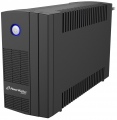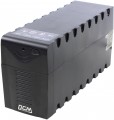Full load operating time
UPS continuous operation time from a fully charged battery when connected to a load with a power equal to the UPS output power (maximum or effective, depending on the type of load, see the relevant paragraphs for details). For a UPS designed to work with a home or office PC, a time of about 10-15 minutes is considered sufficient, this is enough to save data and complete work. To power servers, it is worth using devices with an operating time
of 20 minutes or more.
Half load operating time
UPS continuous operation time from a fully charged battery when connected to a load with a power equal to half the output power of the UPS (maximum or effective, depending on the type of load, see below for details). The operating time with such a load is much longer than for a full load, and even in the simplest models it can reach 20-30 minutes.
Input voltage range
In this case, the input voltage range is implied, in which the UPS is able to supply a stable voltage to the load only due to its own regulators, without switching to the battery. For redundant UPSs (see "Type") this range is quite small, approximately 190 to 260 V; for interactive and especially inverter ones, it is much wider. Some UPS models allow you to manually set the input voltage range.
Output voltage accuracy
This parameter characterizes the degree of difference between the AC voltage at the output of the UPS and the perfect voltage, the graph of which has the shape of a regular sinusoid. The perfect voltage is so named because it is the most uniform and creates the least unnecessary load on the connected devices. Thus, the distortion of the output voltage is one of the most important parameters that determine the quality of the power received by the load. A distortion level of 0% means that the UPS produces a perfect sine wave, up to 5% — slight sine wave distortion, up to 18% — strong distortion, from 18% to 40% — a trapezoidal signal, more than 40% — a square wave.
Efficiency
Efficiency (coefficient of performance) in the case of a UPS is the ratio of its output power to the power consumed from the network. This is one of the main parameters that determine the overall efficiency of the device: the higher the efficiency, the less energy the UPS wastes (due to heating parts, electromagnetic radiation, etc.). In modern models, the efficiency value can reach 99%.
Output waveform
The form of a graph describing the changes in voltage at the output of the UPS.
—
Pure sinewave. The classic AC voltage graph, this is how it changes in an AC network; The sine wave output means that the UPS has little to no distortion compared to the mains. As a result, such power is suitable for any AC technology, and some devices (for example, audio equipment) generally require an exceptionally pure sine wave. However, this requires rather complex technical solutions, and therefore this waveform can be found in expensive interactive and inverter UPSs.
—
Simulated sine wave (approximated). This signal has a shape close to a sinusoid, but the graph line in this case is not smooth, but consists of separate rectangular “steps”. This waveform is provided by most inexpensive UPSs; such devices are inexpensive and quite suitable for powering computer equipment.
Total battery capacity
The capacity of the battery installed in the UPS. For models with multiple batteries, this is both the total working capacity and the capacity of each individual battery: the batteries in such devices are usually connected in series, so that their total capacity corresponds to the capacity of each individual cell.
Theoretically, a higher battery capacity means the ability to power loads of a given capacity for longer. However, in fact, this parameter is more of a reference than practically significant. The fact is that the actual amount of energy stored by the battery depends not only on the capacity in amp-hours, but also on the voltage in volts; this voltage is often not specified in the characteristics, despite the fact that for accurate calculations it must be known. So when choosing, you should focus on more "close to life" characteristics — first of all, on the directly claimed operating time in different modes (see above).
Number of batteries
The number of batteries supplied with the UPS.
In general, this parameter is more of a reference than practically significant: the number of batteries is selected in such a way as to provide the desired performance — primarily the time of continuous operation. First of all, it is worth paying attention to such characteristics when choosing.
Full charge time
The time it takes to fully charge the UPS battery. Note that in this case, this time is calculated according to special rules: not from 0 to 100% of the charge, but from a state in which it is impossible to maintain half the load, up to 90% of the charge. Of course, a full charge will take a little longer. However, this data is closer to practice than the “from 0 to 100%” calculation: the inability to work at half load makes the UPS practically useless, and this condition can be taken as zero, and 90% of the battery is already able to provide a good guarantee in case of a power failure.

